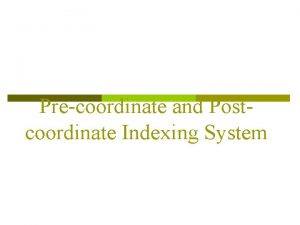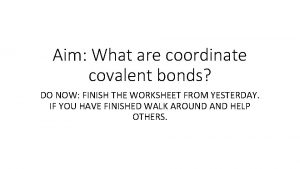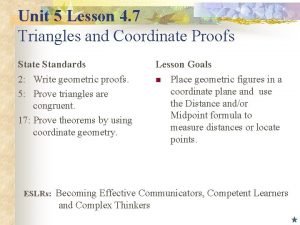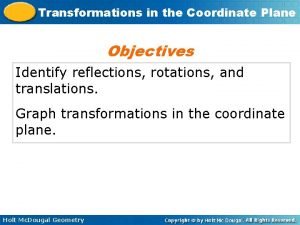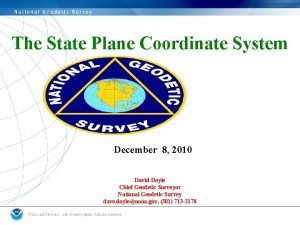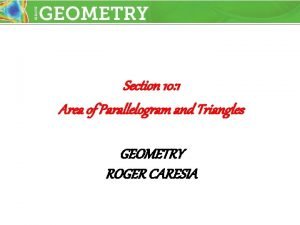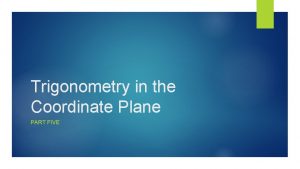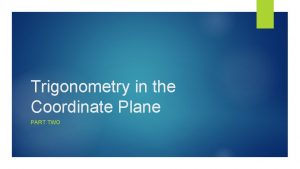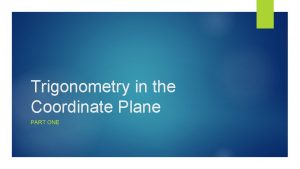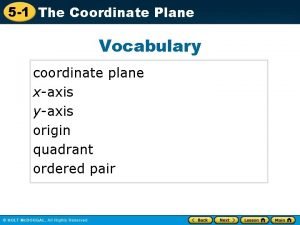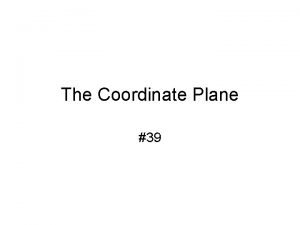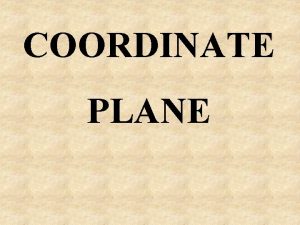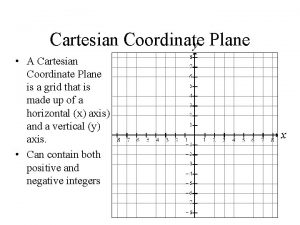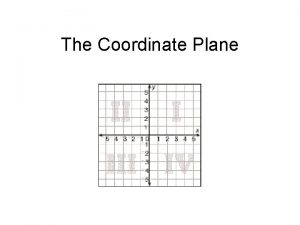Trigonometry in the Coordinate Plane PART THREE Trigonometry









- Slides: 9

Trigonometry in the Coordinate Plane PART THREE

Trigonometry in Coordinate Plane Let’s go back to a basic diagram with a point A on the circle and an angle θ made by drawing the line segment from the origin to A. Point B is made by reflecting point A across the y-axis. We drew a line segment there (in red) and labelled another angle m Two questions: 1. What are the coordinates at point B? 2. How much is angle m?

Trigonometry in Coordinate Plane Answers: 1. Point B would be (-x, y) 2. angle m = angle θ Hopefully this is not a surprise to you. Similarly if we made triangles for each line segment you realize the triangles would be congruent (identical) So their trig values should be the same but there will be a slight difference.

Trigonometry in Coordinate Plane If we label the triangles using the new terminology we see there is one side that is different. The x value is negative for the triangle made at point B. Thus we get the following trig ratios for m: sin m = y/r cos m = -x/r tan m = y/-x So cos and tan are negative in this quadrant leaving only sin as positive.

Trigonometry in Coordinate Plane Similarly, we can reflect point A twice, once in y-axis and then in x-axis to get point C (-x, -y). Making the triangles they again will be congruent with angle k = angle θ The trig values for angle k will be the following: sin k = -y/r cos k = -x/r tan k = -y/-x = y/x In this quadrant, sin and cos are negative leaving tan as the only positive ratio.

Trigonometry in Coordinate Plane Reflecting point A(x, y) in the x-axis gives us point D(x, -y). Using the triangle made for point D we see the trig ratios are: sin g = -y/r cos g = x/r tan g = -y/x In this quadrant sin and tan are negative leaving only cos as positive.

Trigonometry in Coordinate Plane In summary: If the angle is in Quadrant I (between 0 – 90) all trig values are positive If the angle is in Quadrant II (between 90 – 180) only the sin value is positive If the angle is in Quadrant III (between 180 – 270) only the tan value is positive If the angle is in Quadrant IV (between 270 – 360) only the cos value is positive. Note that 0, 90, 180, 270 and 360 are not in any quadrant This is sometimes called the CAST rule.

Trigonometry in Coordinate Plane Let’s check the CAST rule! Pick any angle between 0 and 360 (not including 0, 90, 180, 270, 360) and see if it follows the rule. I’m going to pick 321 degrees. This is in Quadrant IV which means only cos should be positive. Sin 321 = -0. 629 Cos 321 = 0. 777 Tan 321 = -0. 810 Sure enough cos is the only one positive.

STOP MAKE SURE YOU UNDERSTAND THE CAST RULE AND WHY CERTAIN TRIG VALUES ARE NEGATIVE IN THE DIFFERENT QUADRANTS. WHEN YOU ARE READY CONTINUE TO THE NEXT SECTION
 Software-defined networking: a comprehensive survey
Software-defined networking: a comprehensive survey Post coordinate indexing system example
Post coordinate indexing system example Co covalent bond
Co covalent bond Coordinate plane proofs
Coordinate plane proofs Rotations on a coordinate plane
Rotations on a coordinate plane Plane transformations
Plane transformations Pa state plane coordinate system
Pa state plane coordinate system Lesson 12-1 graphing on the coordinate plane answer key
Lesson 12-1 graphing on the coordinate plane answer key Perimeter of a triangle on a coordinate plane
Perimeter of a triangle on a coordinate plane Horizontal axis
Horizontal axis

